Birdfinding.info ⇒ Decreasing over much of its natural range, but still common in a few parts of northern Europe, especially in the Netherlands, Belgium, eastern England, Denmark, southern Sweden, Czechia, and eastern Poland. In North America, it is especially common in eastern Washington, southern Idaho, northern Utah, the Canadian prairies, North Dakota, southern Minnesota, Iowa, the St. Lawrence Valley, and Prince Edward Island.
Gray Partridge
Perdix perdix
Europe and western Asia; introduced in North America.

Approximate distribution of Gray Partridge across North America and Eurasia (native range shown in orange). © BirdLife International 2016
Inhabits open farmland and steppes from the British Isles and southern Scandinavia east to western Mongolia and south to the Mediterranean, central Turkey, northwestern Iran, and northern Kyrgyzstan.
Introduced populations are established across much of North America: in the northern Great Basin from south-central British Columbia south to northern Nevada and northern Utah, and across the northern Great Plains from central Alberta and Saskatchewan south to Wyoming, northern Nebraska, and Iowa, and east to Wisconsin. Separately also in the St. Lawrence Valley from southern Ontario and northern New York across southern Quebec, and on Prince Edward Island and in pockets of Nova Scotia.
Identification
A medium-sized, gray-and-brown partridge with a buffy face, throat, and eyebrow, and chestnut streaks on the sides.
The rump and tail are mostly gray with rusty-brown bars, and the outer tail-feathers are bright rufous-chestnut—most visible in flight, but also frequently flicks its tail open when walking.
The upperparts vary from all-gray to brownish, and often have mixed gray-and-brown barring.
The sexes are similar, except that males have a dark-chestnut belly patch.
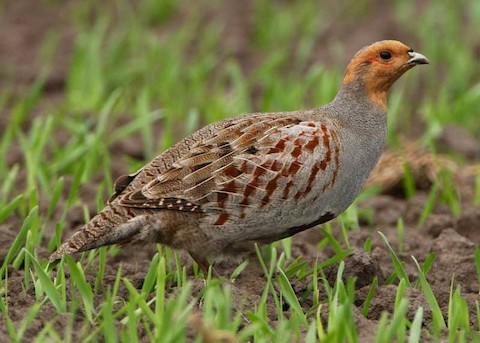
Gray Partridge, male. (Groningen, Netherlands; April 25, 2002.) © Tini & Jacob Wijpkema
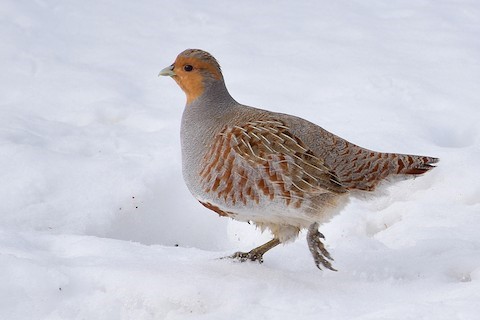
Gray Partridge, male. (Golden Spike National Historical Park, Box Elder County, Utah; January 13, 2017.) © Mike Fish
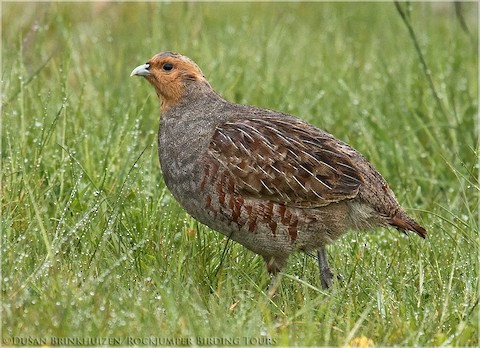
Gray Partridge, female. (Eemshaven, Groningen, Netherlands; May 3, 2015.) © Dušan Brinkhuizen
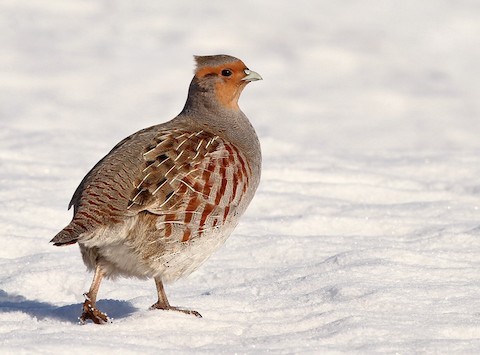
Gray Partridge, showing rusty-brown barring on rump and tail. (Morups Tånge, Hallands län, Sweden; March 15, 2010.) © Lars Petersson
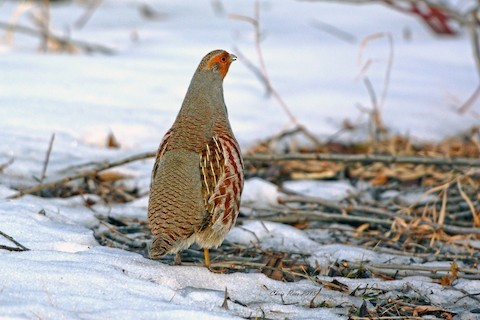
Gray Partridge, showing rusty-brown barring on back, rump, and tail. (Centennial Park, Edmonton, Alberta; March 6, 2015.) © Chris Rees

Gray Partridge, male showing dark-chestnut belly patch. (Wallowa County, Oregon; January 20, 2016.) © cgates326
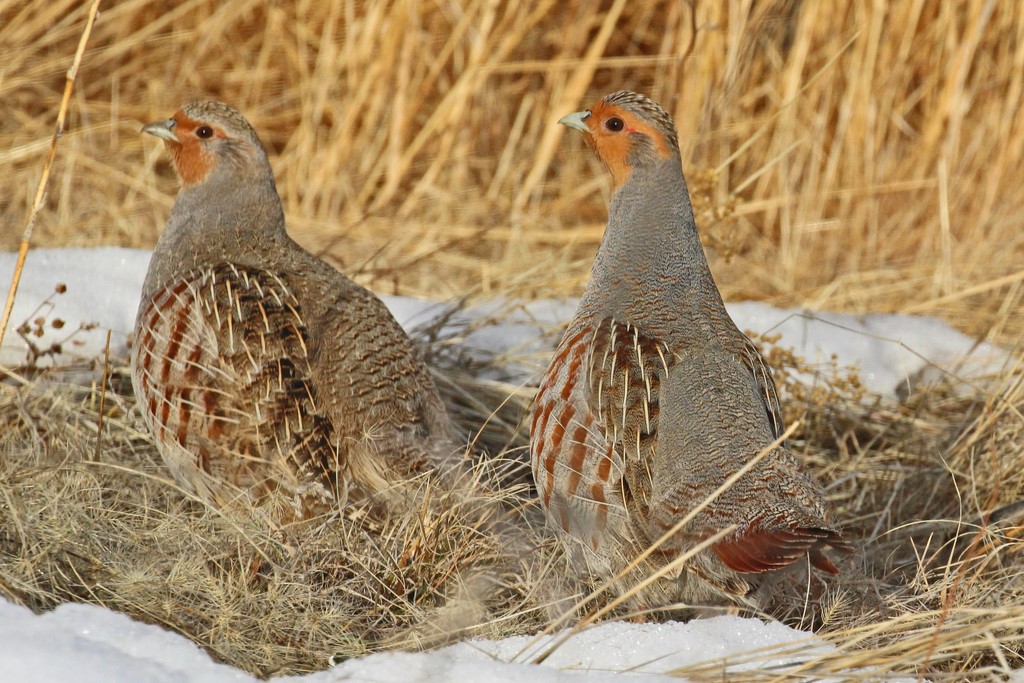
Gray Partridge, pair, with one showing bright rufous-chestnut outer tail-feathers—note that the bird on the left has a mostly brownish back, and the bird on the right has mostly gray upperparts. (Wallowa County, Oregon; January 20, 2016.) © cgates326

Gray Partridge, male showing bold, orderly chestnut barring on the sides. (Lier, Belgium; April 27, 2019.) © ward123

Gray Partridge, immature. (Calgary, Alberta; July 10, 2013.) © Gordon Johnston
Immatures are similar to adults but browner, lacking strong contrast of gray and rusty tones.

Gray Partridge, male showing bold white outline around chestnut belly patch. (Tilburg, Noord-Brabant, Netherlands; December 11, 2014.) © Paul Cools

Gray Partridge. (Midtjylland, Denmark; May 12, 2018.) © Janos Sutyak

Gray Partridge, in flight showing bright rufous-chestnut outer tail-feathers. (Barrhaven, Ottawa, Ontario; March 18, 2017.) © aliuh
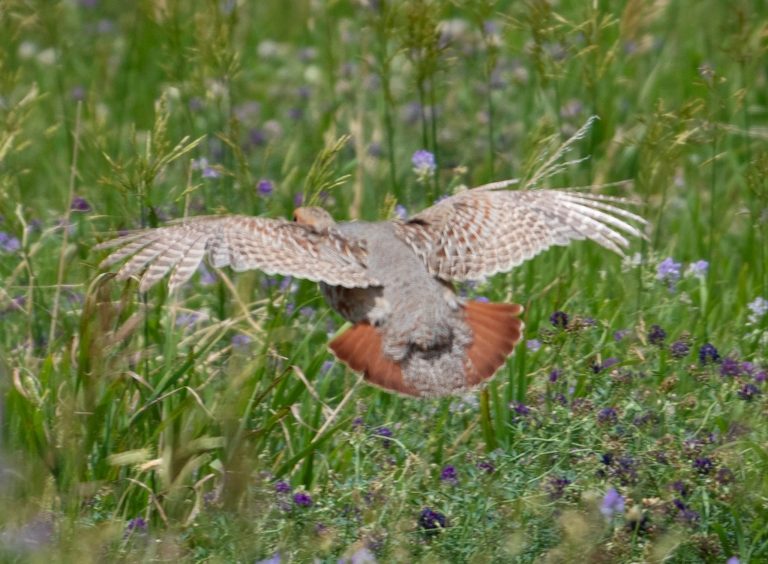
Gray Partridge, in flight showing bright rufous-chestnut outer tail-feathers. (Division No. 3, Saskatchewan; July 14, 2018.) © Owen Ridgen
Notes
Polytypic species consisting of six recognized subspecies.
References
Alderfer, J., and J.L. Dunn. 2014. National Geographic Complete Birds of North America (Second Edition). National Geographic Society, Washington, D.C.
BirdLife International. 2016. Perdix perdix. The IUCN Red List of Threatened Species 2016: e.T22678911A85929015. https://dx.doi.org/10.2305/IUCN.UK.2016-3.RLTS.T22678911A85929015.en. (Accessed March 27, 2020.)
eBird. 2020. eBird: An online database of bird distribution and abundance. Cornell Lab of Ornithology, Ithaca, N.Y. http://www.ebird.org. (Accessed March 27, 2020.)
Madge, S., and P.J.K. McGowan. 2002. Pheasants, Partridges, and Grouse: A Guide to the Pheasants, Partridges, Quails, Grouse, Guineafowl, Buttonquails, and Sandgrouse of the World. Princeton University Press, Princeton, N.J.
McGowan, P.J.K., and G.M. Kirwan. 2020. Grey Partridge (Perdix perdix). In: del Hoyo, J., Elliott, A., Sargatal, J., Christie, D.A. & de Juana, E. (eds.). Handbook of the Birds of the World Alive. Lynx Edicions, Barcelona. https://www.hbw.com/node/53427. (Accessed March 27, 2020.)
Mullarney, K., L. Svensson, D. Zetterström, and P.J. Grant. 1999. Birds of Europe. Princeton University Press, Princeton, N.J.
Salt, W.R., and J.R. Salt. 1976. The Birds of Alberta. Hurtig Publishers, Edmonton, Alberta.
Sibley, D.A. 2000. The Sibley Guide to Birds. Alfred A. Knopf. New York.
Xeno-Canto. 2020. Grey Partridge – Perdix perdix. https://www.xeno-canto.org/species/Perdix-perdix. (Accessed March 27, 2020.)
